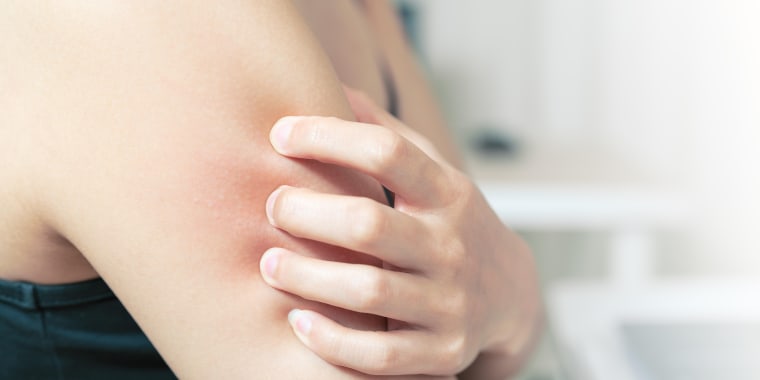Swimming in the lake, hiking through the woods and roasting marshmallows by the campfire: Those are some of the most enjoyable outdoor summer pastimes.
But the downside of all that summer fun can sometimes be an unwanted brush with nature that leaves us quite irritated — and itchy and red.
“There’s a lot more opportunity to get into stuff that would cause a rash if the weather is nice,” says Dr. Carolyn Jacob, a dermatologist in private practice in Chicago.
Here’s what you need to know about five common rashes that could show up this summer, just like an uninvited house guest. The summer rash pictures can also help you identify which rash you may have.
Types of summer rashes
- Poison ivy
- Sun poisoning
- Lyme disease
- Summer heat rash
- Insect bites
Poison ivy
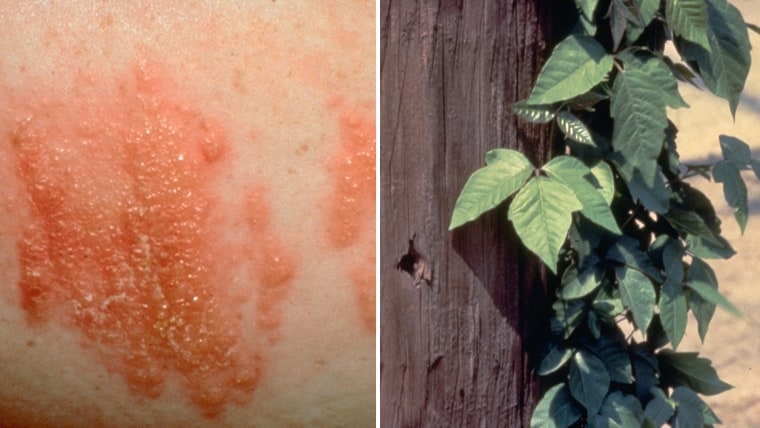
“It’s extremely itchy,” says Dr. Cameron Rokhsar, an associate clinical professor of dermatology at Mount Sinai Hospital and dermatologist in private practice in New York. “It can be all over your body and it’s extremely uncomfortable.”
The plants poison ivy, poison oak, and poison sumac contain an oil, urushiol, that can cause an allergic reaction after it brushes across the skin. The blistering rash from any of these plants looks the same and many — but not all — people have the allergy. The rash often appears 12 to 72 hours after exposure and typically starts as red streaks that form into blisters.
Poison ivy is no fun.
Calamine lotion, hydrocortisone cream or an antihistamine like Benadryl may be recommended over-the-counter treatments, but they are often not strong enough.
“Patients need treatment,” Rokhsar says. “They can’t do it on their own.”
Strong topical or oral steroids are often prescribed to calm the rash down, he said. If you’ve come in contact with the plants, wash your skin and clothing to remove the oil, Jacob says.
Tip: The oil can stick to pet fur, so if your dog was with you when you were exposed, it’s bath time, says Jacobs. Also, even dead poison ivy can contain the oil, so beware.
Sun Poisoning
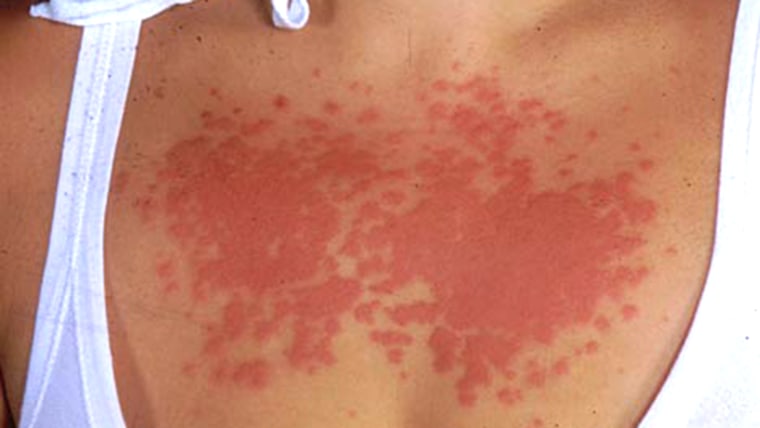
While some might casually refer to a bad sunburn as sun poisoning, they are not the same thing.
Sun poisoning, or polymorphic light eruption, is an allergic reaction to the sun that causes an itchy, red, bumpy rash, Rokhsar says. You can use hydrocortisone cream or an oral antihistamine from the pharmacy for immediate relief, but he recommends seeing a dermatologist to rule out other sun-sensitive rashes and for treatment, typically a steroid cream and staying out of the sun.
Tip: Jacob said the reaction is common at the start of the summer when the skin hasn’t been exposed to the sun in quite some time.
“It is an overreaction to UVB rays of the sun when you haven’t seen it in a while,” she said. The rash is often found on the forearms, chest and neck.
Lyme disease
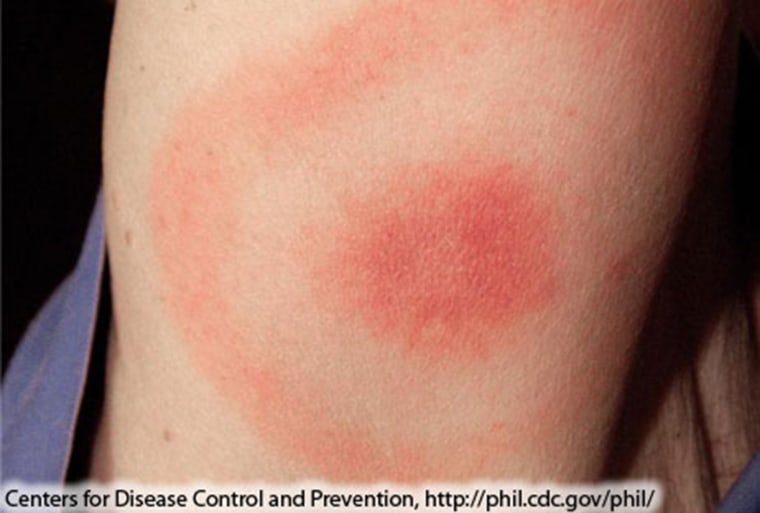
Most people who become infected with Lyme disease develop a rash known as an Erythema migrans rash. The classic look is a circular rash that expands and often resembles a bull’s eye, with a dark center where the tick bite occurred, an area of clearing and an outer ring of pink or red.
The rash, though, doesn’t always have that clearing and can appear as a round, solid red rash without the central target, Rokhsar says. Sometimes, people have more than one rash and they can show up any place on the body.
“We tend to see a lot of them on the torso but it could be anywhere, theoretically,” Jacob said.
If you find this rash, see a doctor immediately because the earlier Lyme disease is treated with antibiotics, the better.
“It’s curable when you catch it early,” Rokhsar says. “Early treatment can prevent long-term adverse events associated with Lyme disease. It’s urgent to get treatment as soon as possible.”
When Lyme is untreated or the diagnosis and treatment are delayed, he said, the infection can cause serious complications and affect the heart, brain and musculoskeletal systems. “If it’s not treated, it will progress into something worse and can affect different organ systems,” Jacob said.
Tip: The rash occurs in about 70 to 80 percent of infected people, according to the Centers for Disease Control and Prevention, so you can still have the infection even if you don’t have the rash.
Heat Rash
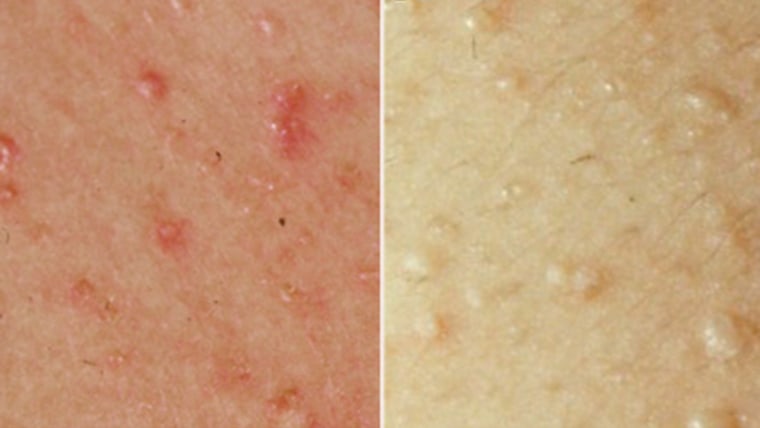
The heat can cause rashes when sweat ducts, found all over your body, are blocked and sweat is unable to come out of your skin, Rokhsar says.
It can happen if you’re wearing thick clothing, heavy creams or are in extreme heat. In young children, it tends to happen in the diaper area. The rash can take different forms like red patches, tiny blisters or pus bumps and it is sometimes itchy. The treatment is to cool down and unblock your skin, Rokhsar says, by getting out of the heat, taking a cool shower and letting your skin breathe.
Tip: The rash should clear up in a day or two. “If it doesn’t go away, it’s not a heat rash,” Rokhsar says.
Insect bites
The mark (or marks) of those pesky mosquito, flea or spider bites also can be considered a rash. Those bites can cause small, itchy bumps that drive us crazy. You can try over-the-counter treatments like hydrocortisone cream, calamine lotion, antihistamines or lotion with menthol to cool the skin, Jacob said.
If the bites are not better in two days, she recommends a trip to the dermatologist.
Tip: A spider bite sometimes appears as one large bump that is not itchy, Jacob said. Spiders don't often bite. Black widow and brown recluse spiders are the only two spider species in North America whose bites may cause symptoms more serious than minor pain and swelling. Other spider bite symptoms include: headache; nausea; vomiting; fever; and chills, according to the Centers for Disease Control and Prevention. If you suspect you've been bitten by a black widow or brown recluse, don't panic. Wash the area with soap and water, apply a cold compress to reduce swelling and don't attempt to remove the venom.
Related:
